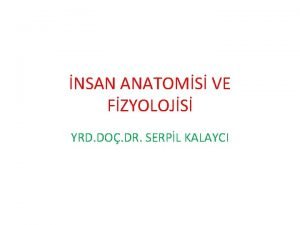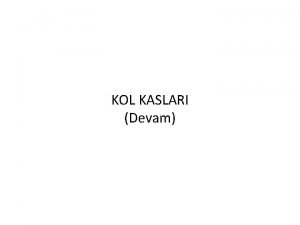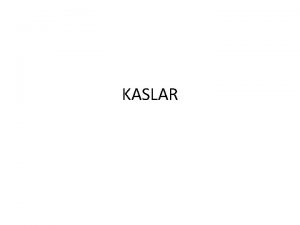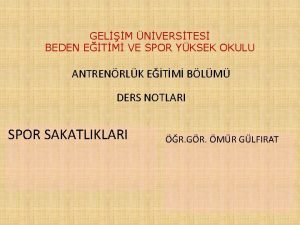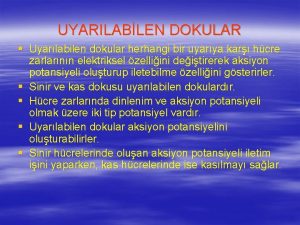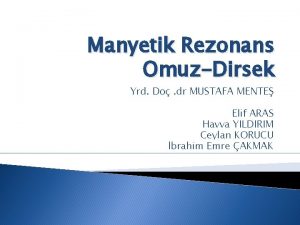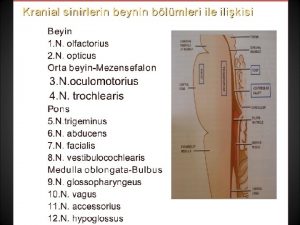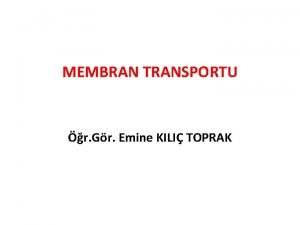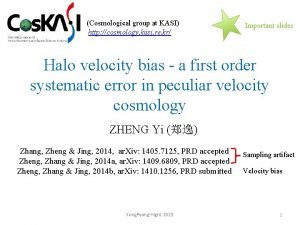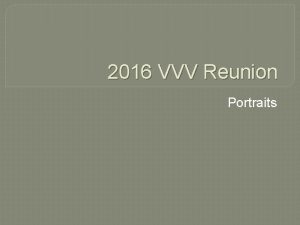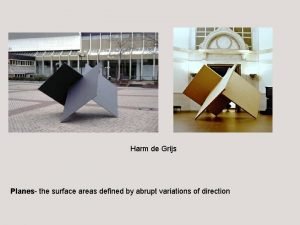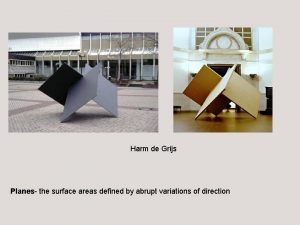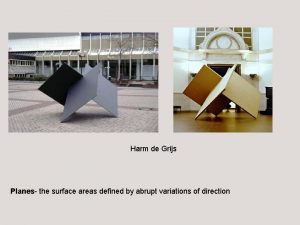The VVV Templates Project KASI Richard de Grijs


















- Slides: 18

The VVV Templates Project 손정주 (한국교원대학교) 전영범, 성현일 (KASI) 한장희, 이종택 (한국교원대학교) Richard de Grijs (Kavli Institute for Astronomy & Astrophysics) Rodolfo Angeloni (la Pontificia Universidad Catolica(PUC) -Chile) 2014 SURVEY SCIENCE GROUP WORKSHOP


VVV Project The Vista Variables in the Vía Láctea (VVV) ESO Public Survey ESO's Visible and Infrared Survey Telescope for Astronomy 4 m telescope a wide near-infrared (IR) camera (VIRCAM) a mosaic of 16 2048 x 2048 detectors 0. 8 -2. 5 micron an average pixel scale of 0. 34"/pixel Fo. V : 1. 1 x 1. 5 square degrees 1 magnitudes deeper than their 2 MASS counterparts provide a window into time-variable phenomena a time span of about 5 years, with a total of 1929 hours of observing time

VVV Project Of order 109 point sources within a total sky area of 520 deg 2 will be monitored. The surveyed region includes 36 globular clusters and about 314 known open clusters. A deep IR atlas in 5 passbands and a catalogue containing an estimated 106 variable stars.

Light Curve Templates in the Near-IR: Towards Automated Classification of VVV Light Curves for Cataclysmic Variable Stars Cataclysmic Variables have been extensively observed at optical, ultraviolet, and X-ray wavelengths, where their white dwarf primary stars and bright accretion disks dominate the spectral energy distribution. Unfortunately, little is known about their infrared properties. The assumption that infrared observations would reveal only the “uninteresting” secondary star has been shown to be false, as recent investigations have instead shown. A shorter time-scale it will provide a unique chance of enlarging our specific knowledge of the cataclysmic phenomenon. In particular, time-series of NIR photometry would allow us to measure the ellipsoidal variations of the tidally distorted mass-donor star as well as irradiation effects. By modeling the modulation, we could then put strong constraints on fundamental parameters such as the geometry of the binary, and, in case of the contribution of the mass-donor star in two or more bands is known, it is possible to infer its spectral type (and surface temperature) and to estimate the distance to the binary via photometric parallax.

Light Curve Templates in the Near-IR: Towards Automated Classification of VVV Light Curves for Cataclysmic Variable Stars Unlike previous variability surveys, such as MACHO and OGLE, the VVV Survey will be carried out in the near-IR, mainly in the K band. While this will allow us to probe deeper into the heavily obscured regions of the Galactic bulge and plane than ever before, it also presents us with important challenges. In particular, the extensive, high-quality templates that are needed for automated variable star classification algorithms are not available in the near-IR. We have thus to build a large database of well-defined, high-quality, near-IR light curves for variable stars of different types, which will form the basis for the VVV automated classification. This database will be critical for the successful outcome of the VVV Survey.

Light Curve Templates in the Near-IR: Towards Automated Classification of VVV Light Curves for Cataclysmic Variable Stars In order to properly classify as a template, a light curve must meet some minimum observational criteria first, the observations must be very precise, with the relative error in the photometry being less than about 1/10 of the light curve amplitude. Second, the light curve itself must be complete, without any clear gaps. This is of great importance to properly compute accurate Fourier decomposition parameters for the light curves, as needed in order to feed the automated classification algorithms. Jones et al. (1996)

VVV Templates Project SCIENTIFIC GOALS The main goal is to derive well-defined light curve templates in the near-IR for the automated classification of VVV light curves. RR Lyrae stars in the globular cluster ω Centauri (Del Principe et al. 2006).

VVV Templates Project Targets # Name α (J 2000) δ (J 2000) K mag. P[d] Var. type -------------------------------------------------01) V Sge 20 20 14. 69 +21 06 10. 39 9. 811 0. 5142 Novalike, Supersoft X-ray source 02) AE Aqr 20 40 09. 16 -00 52 15. 07 8. 780 0. 4151 Intermediate Polar 02) UU Aqr 22 09 05. 76 -03 46 17. 70 12. 483 0. 1636 SW Sex star 03) FO Aqr 22 17 55. 38 -08 21 03. 90 12. 508 0. 2018 Intermediate Polar 04) AO Psc 22 55 17. 99 -03 10 40. 00 13. 088 0. 1496 Intermediate Polar 05) IP Peg 23 23 08. 55 +18 24 59. 30 11. 721 0. 1582 Dwarf Novae 06) RX And 01 04 35. 54 +41 17 57. 80 11. 56 0. 2099 Z Cam star 07) HT Cas 01 10 13. 13 +60 04 35. 40 13. 84 0. 0736 SU UMa star 08) AY Psc 01 36 55. 45 +07 16 29. 30 14. 002 0. 0993 Nova-like, RW Tri star 09) RW Tri 02 25 36. 15 +28 05 50. 90 11. 46 0. 2319 Nova-like variable 10) GK Per 03 31 11. 82 +43 54 16. 80 ~13 1. 9968 Intermediate Polar, Fast Novae 11) V 1309 Ori 05 15 41. 41 +01 04 40. 50 13. 512 0. 3326 polar/AM Her system 12) U Gem 07 55 05. 24 +22 00 05. 10 10. 83 0. 1769 SS Cyg star 13) SU UMa 08 12 28. 26 +62 36 22. 50 11. 670 0. 0076 Prototype of the SU UMa stars 14) Z Cam 08 25 13. 20 +73 06 39. 23 10. 856 0. 2898 Prototype of the Z Cam stars 15) GY Cnc 09 09 50. 55 +18 49 47. 50 13. 118 0. 1754 SS Cyg star

Telescopes Europe Italy - Osservatorio Astronomico di Padova (INAF-OAPd) 92 cm Telescope, delta Scuti, SX Phe Spain - Instituto de Astrofísica de Canarias (IAC) 1. 52 m, CAIN III, delta Scuti, SX Phe

Telescopes Africa IRSF Telescope : 1. 4 m, RR Lyrae in globular clusters (M 62, NGC 1851), delta Scuti in open clusters (NGC 6134) 0. 75 -m Telescope : delta Scuti, SX Phe, Ellipsoidal, Eclipsing binaries

Telescopes North America Canada Maxico : 2. 12 m, CANICA beta Cephei and delta Scuti South America Chile Asia Kazakshutan South Korea : 1. 8 m BOAO

Bohyunsan Optical Astronomy Observatory (BOAO)

KASINICS (KASI Near Infrared Camera System) - cooling temperature : sensor part = 30 K - temperature of cold box < 80 K - Pixel scale : 0. 39" x 0. 39" - Field of view : 3. 3' x 3. 3' - Gain(e-/ADU) : 2. 56 - Readout Noise : 39 electrons - Dark Current : 18. 2 electrons/sec - Average Seeing(BOAO) : 1. 5" ~ 1. 7" - Filter : total 6 (J, H, Ks, L, H 2, H 3+)

Light Curve of BL Cam : The Preliminary result of VVV light curve templates BL Cam, 2 MASS R. A. (J 2000) 03 h 47 m 19. 8 s Dec. (J 2000) +63° 22’ 43” Brightness <V> ~ 13. 1 mag Period [d/h] 0. 03909/0. 93834 - Low metallicity ([Fe/H]=-2. 4) - High amplitude - Short period and multi - periodicity - One of well known 12 field SX Phe star

Light Curve of IP Peg : The Preliminary result of VVV light curve templates α(J 2000) : 23 23 08. 55, δ(J 2000) : +18 24 59. 30 K mag : 11. 721, P[d/h] : 0. 1582/3. 7968 dwarf nova - U Gem type 동반성에서 백색왜성을 둘러싸고 있는 강착원반으로 물질 유입이 이루어지고 있는 천체. 불규칙한 주기의 outburst – 가시광에서 2등급 정도 밝아지는 것으로 알려져 있음. Inclination : 80° ~ 85° Mass ratio (q)=0. 42 Distance = 115± 30 pc to the system

Light Curve of CVs : The Preliminary result of VVV light curve templates Name IPPeg RW Tri UU Aqr BL Cam V 1007 Cas V 2416 Cyg AY Psc KV Per RX And V 460 And AM Her V 1047 Her BO Lyn period(d/h) 0. 1582/3. 7968 0. 2319/5. 5656 0. 1636/3. 9264 0. 03909/0. 93834 0. 0332/7. 968 0. 05589/1. 34136 0. 0993/2. 3832 0. 2491/5. 9784 0. 2099/5. 0376 0. 0749808/1. 8 0. 1289/3. 0936 0. 3207/7. 6968 0. 0934 / 2. 2416 observation time 19: 20 – 2: 30 20: 30 – 5: 00 19: 20 – 00: 20 20: 30 – 5: 00 19: 20 – 4: 40 19: 20 – 1: 00 20: 30 – 4: 30 19: 20 – 5: 00 20: 00 – 5: 00 19: 20 – 23: 00 2: 30 – 5: 00 19: 20 -21: 00 data 8 h관측(2주기) 7 h관측(1. 3주기) 5 h 관측(1. 2주) 5 h 관측(5주기) 9 h 관측(1. 1주기) 7 h 관측(5. 3주기) 8 h 관측(1. 3주기) 2 h 관측(0. 4주기) 9 h 관측(5주기) 24 h 관측(3주기) 36 h 관측(16주기)

Thank you!
 Richard iii and looking for richard
Richard iii and looking for richard Powerpoint templates for graduation project
Powerpoint templates for graduation project Cdc project management templates
Cdc project management templates Workforce training innovation fund
Workforce training innovation fund Detrusor kası
Detrusor kası Deltoideus origo insertio
Deltoideus origo insertio Vastus lateralis kası
Vastus lateralis kası Anatomik enfiye çukuru
Anatomik enfiye çukuru M rhomboideus major
M rhomboideus major Kasi car wash ideas
Kasi car wash ideas Diaphragma crus dextrum
Diaphragma crus dextrum Sakroiliak eklem egzersizleri
Sakroiliak eklem egzersizleri Peritübüler kapiller
Peritübüler kapiller Sartorius kası
Sartorius kası Tropomyozin
Tropomyozin M. corrugator supercilii görevi
M. corrugator supercilii görevi Korakobrakialis kası
Korakobrakialis kası Mlf lezyonu
Mlf lezyonu Platolu aksiyon potansiyeli nedir
Platolu aksiyon potansiyeli nedir




